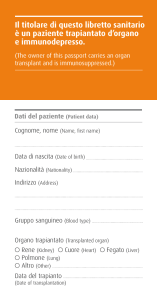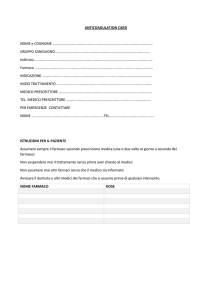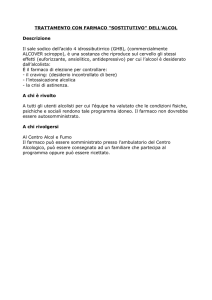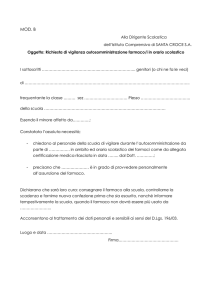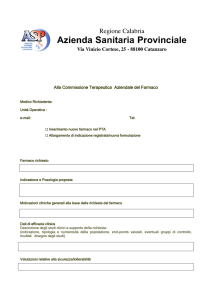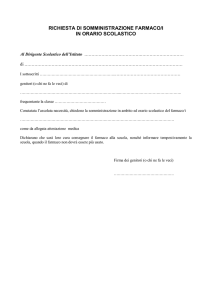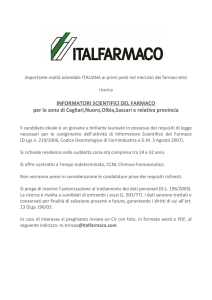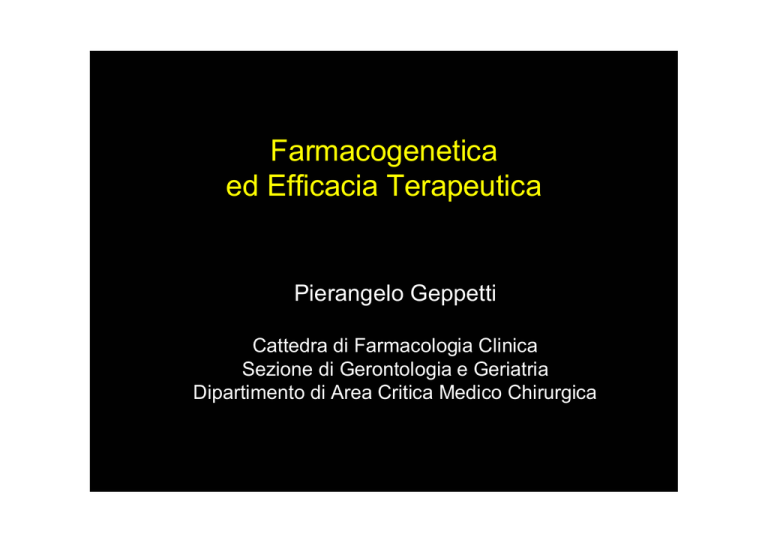
Farmacogenetica
ed Efficacia Terapeutica
Pierangelo Geppetti
Cattedra di Farmacologia Clinica
Sezione di Gerontologia e Geriatria
Dipartimento di Area Critica Medico Chirurgica
215
207 (- 4%)
153 (- 28%)
EU - 34%
Fenotipo: Sicurezza
Nel 2007, 28 farmaci ritirati dal commercio per ADR letali (TdP)
16% dei farmaci in commercio è associato a ADR gravi,
riportate sul scheda tecnica (Spear B, 2001)
>100 000 morti all’anno negli USA rappresenta la quarta causa di
morte dopo malattie cardiovascolari, tumori e ictus (Lazarou et al,
1998)
ADR lievi/moderate ↓ la compliance influenzando la risposta
(Spear B, 2001)
Motivazioni per preferire un farmaco
Casi Recenti
• Rofecoxib
• Cerivastatina
Variabilità nella efficacia terapeutica dei farmaci
% pazienti
scarsa risposta
Antagonisti dell’angiotensina 2
ACE inibitori
Beta-bloccanti
Antidepressivi triciclici
Agonisti beta-2 adrenergici
10-25%
10-25%
15-25%
20-50%
40-70%
Spear et al. Trends in Molecular Medicine, 7:201
(2001)
La variabilità individuale nelle
risposte ai farmaci è dovuta a fattori:
• Fisiologici
età, sesso, peso corporeo, condizione fisica
• Patologici
malattie, livello di funzionalita’ epatica o
renale
• Ambientali
dieta, alcool, tabacco, altri farmaci
• Genetici
polimorfismi
Pharmacogenetic Strategy Applied to the Practice of Medicine
GCCCGCCTC
GCCCACCTC
From McLeod and Evans, Ann Rev of Pharmacol and Toxicol, 2001: 41,101-121
Genotipo
SNP - Single Nucleotide Polymorphisms
…G G T A A C T G…
Polmorfismo
…G G C A A C T G...
Associazione (SNP)
Responders
No responders
T
Predittivi della
presenza del fenotipo
Predittivi dell’assenza
del fenotipo
A
Risposta al farmaco: determinanti poligenici
Evans W and McLeod H. N Engl J Med 2003;348:538-549
Farmacogenetica
Associazione
genotipo
Marker predittivi
SNPs
fenotipo
Risposta al farmaco
Terapia personalizzata
‘right medicine, right dose, to right patient’
Per quali farmaci dobbiamo sviluppare PGX test?
1.
2.
3.
4.
Consistente variabilità interindividuale
Indice terapeutico ristretto (warfarin)
ADR gravi ed inaspettate (carbamazepina-SJS)
Trattamento cronico con insorgenza dell’effetto
ritardata nel tempo (SSRI)
Efficacia
Sicurezza Scelta del miglior dosaggio
Farmaco
in sviluppo
Farmaco
sul mercato
Farmaco
ritirato dal commercio
Vigabatrin
(Riduzione Campo visivo 30%)
PGX e sperimentazione dei nuovi farmaci
NEW DRUG APPLICATIONS
BIOLOGIC LICENSE APPLICATIONS
Allen R et al, 2004
Prospective efficacy/safety pharmacogenetics
Prospective efficacy
Identifying
non-responders and
hyper-responders
Target selection
Pathway analysis
Target
Lead
Candidate
Phase 1
Phase 2
Risk Management
Post Marketing
Surveillance
Phase 3
Regn
Identifying AEs during full development
Predictive
Toxicology
Allen R et al, 2004
Launch
Tranilast and TATA box UGT1A1
Esempio di ADR comuni durante trials
Durante Phase III: 12% dei pazienti ↑ bilirubina
2.5
3.50
3.00
2.50
control s'(n=1085)
2.00
cases (n=146)
1.50
1.00
0.50
livelli di bilirubina (mg/dl)
livelli di bilirubina (mg/dl)
4.00
2
1.5
pre-tranilast
pos t tranilast
1
0.5
0
0.00
preTranilast
postTranilast
66
67
77
TA repeat genotype
7- repeat in TATAA box of UGT1A1 (UDP-glucuronosyltransferase 1)
Allen R et al, 2004
Development Cost Benefits from Pharmacogenetics
Base Case, Total = $324M
PreClin
54
Phase 1
Phase 2
27
41
30
38
Phase 3
Phase 4
With PGx, Total = $245M
48
160
31
94
45
Allen R et al, 2004
During Drug Development: PGX May Identify Failures in Advance
others
Commercial Reasons
Human Safety
Animal Toxicity
Lack of Efficacy
PK
0%
10%
20%
30%
40%
50%
Allen R et al, 2004
PGX postmarketing: the abacavir case
Abacavir inibitore della trascriptasi inversa
4.3 % dei pazienti trattati sviluppa Hypersenstivity Reaction potenzialmente
letale
HLA-B57 allele is a significant predictor of the occurrence of the
hypersensitivity reaction (Hetherington et al. 2002; Mallal et al. 2002).
Genetic testing è costo-efficace (Hughes et al. 2004).
Candidate gene association study and PGX
DRUG
TARGETS
DRUG
TRANSPORTERS
PHARMACODYNAMICS
Variability in
Efficacy/Toxicity
Johnson JA. Trends in Genetics 2003: 660-666
DRUG
METABOLIZING
ENZYMES
PHARMACOKINETICS
Breakdown of Genotyping and Phenotyping in FDA
Survey
Others
Receptors
Pgp
CYP 2D6
PhaseII
CYP1A2
CYP3A4/5
CYP2C19
CYP2C9
• Genotyping and phenotyping performed in some submissions
• Phase II enzymes measured: NAT-2, UGT, GSTM1, etc
• Receptors: Dopamine, 5-HT, beta-adrenergic, alpha-1 adrenergic, potassium channels, etc
• Others: HMC, CETP, AAG, ApoE etc.
PGX e pratica clinica
(Spear B, 2001)
Warfarin
(Spear B, 2001)
PGX test approvati dalla FDA ed in commercio
PK test
1. 2005 AmpliChip® per comuni
polimorfismi su CYP2D6 and
CYP2C19
1. Thiopurine Methyltransferase
(TPMT)- activity
PD test
1. Human Epidermal Growth
Factor Receptor 2 (HER2)overexpression (Fish test)
chemoterapici
Predisposizione genica acquisita
Studi retrospettivi
recenti
FDA ha approvato 22 molecole includendo i risultati di PGX
Nuove prospettive
candidate gene-based studies
genome-wide scan association studies
Biomarkers su tutto il genoma
Importante per studiare nuovi target
↑ numerosità
studi multicentrici
1. Human genome
2. Dense genotyping chips
3. Well characterized clinical samples
Coronary Artery Disease
Hypertension
Rheumatoid arthritis
Diabetes I and II
Breast cancer
Multiple sclerosis
Ankylosin spondylitis
Autoimmune thyroid disease
Pharmacogenetics


